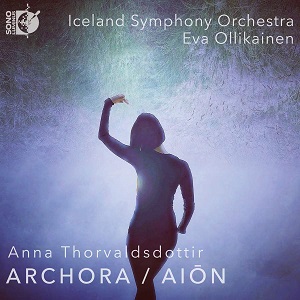
Anna Thorvaldsdottir (b. 1977)
ARCHORA (2022)
AIŌN (2018)
Iceland Symphony Orchestra/Eva Ollikainen
rec. 2022, Harpa Concert Hall, Reykjavik, Iceland
Sono Luminus DSL92268 CD/Blu-ray [62]
Anna Thorvaldsdottir was a featured composer at the 2023 Aldeburgh Festival, and the second work here, Aiōn, had its UK premiere there. Other pieces of hers were played, and she gave a public interview with Roger Wright, CEO of Britten Pears Arts which runs the Festival. I was there. Our party’s reactions to this music ranged from bewilderment to fascination; one of the professional musicians among us articulated concerns about a seeming lack of form and musical trajectory, to they heard “just sounds”. “Ah, but what sounds!” reacted another; and the world’s leading orchestras have been joining the queue to commission and play Thorvaldsdottir’s work. None of us dismissed it. Like one’s first taste of beer, it may seem unappealing but stays with you, so you return to it to increase your appreciation.
Much Western classical music is founded on the notion of a journey, a structure in which contrasting themes recur but are changed by the end. Symphonies and sonatas depend on our recognition of staging posts along the way. These two pieces follow a different, if sometimes related, process. Thorvaldsdottir’s Aldeburgh interview and concert programme notes are echoed in her booklet notes for this issue. They may not always be as illuminating as one might wish, but she describes something very personal to her work and her inspiration, rather than how she took an existing template like sonata form. Like many descriptions, they may be best read after hearing the music. She writes of Archora, her 2022 BBC co-commission:
“The core inspiration behind Archora centres around the notion of a primordial energy and the idea of an omnipresent parallel realm – a world both familiar and strange, static and transforming, nowhere and everywhere at the same time. The piece revolves around the extremes on the spectrum between the Primordia and its resulting afterglow – and the conflict between these elements that are nevertheless fundamentally one and the same.”
The piece presents a duality, then, the relation between some foundational source of energy (“arché”) and an elusive parallel realm (“chora”). The former is heard at the outset in a low rumble from bass clarinet, contrabassoon, bass trombone, tenor and bass tubas, cellos and basses. The wind players have to take breath asynchronously to keep this going. Gradually we emerge in a new place, without being quite sure how we got there. More than one critic mentions Sibelius in the way the music grows, and relates to nature, as well as the connection to the subterranean processes forming the composer’s native country, Iceland. New perspectives are seen, but much material is fleeting or elusive, there are unsettling effects such col legno slaps, percussive tics, and slithering glissandi. From about 12:30 a new lyrical melody emerges, or perhaps a new vista on the existing material. For it is as if the material is generating the form, as Thorvaldsdottir implies in her note. But it all adds up to a compelling twenty-minute single movement.
Aiōn is a Greek god of time – cyclic time, perpetual and ritualistic. Thorvaldsdottir’s forty-minute Aiōn was commissioned by the Iceland and Gothenburg Symphony Orchestras. Its three movements are entitled Morphosis, Transcension and Entropia. The composer says:
“The work is inspired by the abstract metaphor of being able to move freely in time, of being able to explore time as a space that you inhabit rather than experiencing it as a one-directional journey through a single dimension. Disorienting at first, you realize that time extends simultaneously in all directions and whenever you feel like it, you can access any moment. As you learn to control the journey, you find that the experience becomes different by taking different perspectives – you can see every moment at once, focus on just some of them, or go there to experience them. You are constantly zooming in and out, both in dimension and perspective. “
One could interpret that description of time – something “you inhabit rather than experiencing it as a one-directional journey” – as a plea not to listen for some quasi-sonata form. All the same, the three movements do hint at the symphonic, and there is a recurrence of material in the last movement. We are at once in the same musical universe, with many of the same orchestral devices, as in Archora. There are pitch-less features from the circular bowing of the strings, breathy exhalations from the winds at the start, and the suggestion of vast cosmic movement through the avoidance of a regular pulse, use of long pedals and slowly shifting textures. (Eva Ollikainen, who also conducted the work in Aldeburgh, made large slow gestures.) The dense chord clusters, low registers, long pedals, Bartókian pizzicati, thunderous big bass drum rolls, trombone blasts – it is all eventually subdued by a summarising long melodic line which emerges at the close. Thorvaldsottir agreed in interview that, while it all can be approximated by electronic means, she loves the orchestra and the humanity of its sound even when she hears it as a single organism. And it shows.
The Iceland Symphony Orchestra under Eva Ollikainen play with high commitment, and sound completely at home in the idiom. The surround sound is very fine. In fact, the Audio Blu-ray is demonstration quality, and the three bass drums will really give any subwoofer a workout. The booklet is in English. In addition to the composer’s own comments, there are Doyle Armbrust’s good, and very enthusiastic, programme notes. Everyone curious about what new music can encompass should hear – or should I say encounter – this art. How many living composers could you recognise after a few minutes of blind listening?
Roy Westbrook
Previous review: Gregor Tassie (July 2023)
Help us financially by purchasing from





















